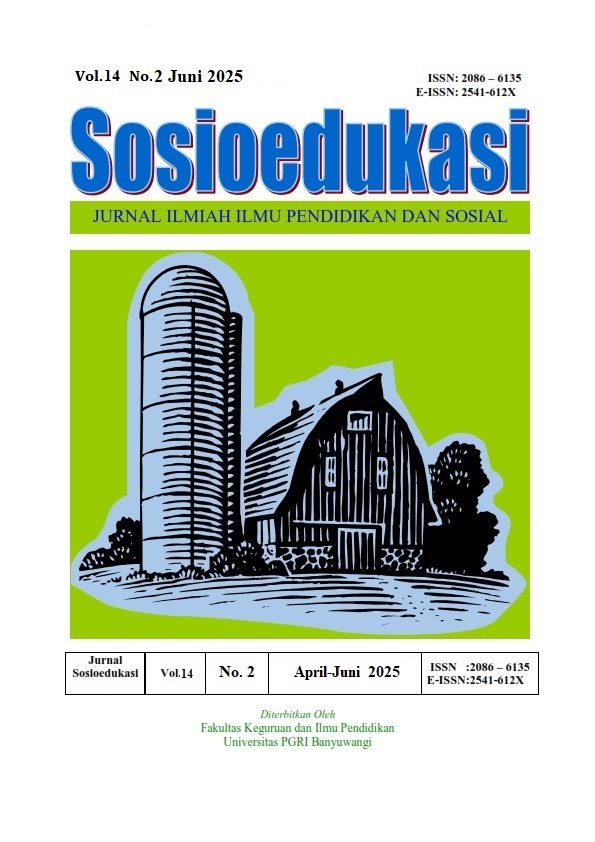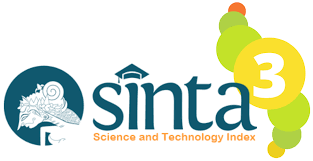STUDENTS’ PERCEPTIONS OF TECHNOLOGY INTEGRATION AND MEDIA USE IN LEARNING ACTIVITIES: A MIXED-METHODS APPROACH
DOI:
https://doi.org/10.36526/sosioedukasi.v14i1.5467Keywords:
Students’ perceptions, technology integration, English language learningAbstract
This study investigates university students’ perceptions of technology integration and media use in English language learning using a mixed-methods approach. Quantitative data were collected from 432 students via a Likert-scale questionnaire and analyzed through descriptive and inferential statistics, including Mann-Whitney U and Kruskal-Wallis H tests. The findings showed a generally positive perception (M = 48.30, SD = 5.81), with no significant differences based on gender (p = .163), but a significant variance based on semester level (p = .026), indicating improved perception with higher academic exposure. Qualitative data from interviews with selected students revealed five central themes: ease of access, technical challenges, platform overload, preference for blended learning, and the influence of prior digital experience. Students favored media such as Kahoot, videos, and animations for their engaging features, although their long-term impact on learning was questioned. Participants with earlier exposure to digital tools adapted more confidently, while others initially struggled. Both statistical and thematic analyses highlight the importance of pedagogical alignment, infrastructure stability, and gradual digital familiarization. The study underscores that technology and media can enhance English learning when meaningfully integrated into instruction and supported by institutional strategies.
References
Akram, H., Abdelrady, A. H., Al-Adwan, A. S., & Ramzan, M. (2022). Teachers’ Perceptions of Technology Integration in Teaching-Learning Practices: A Systematic Review. Frontiers in Psychology, 13(June), 1–9. https://doi.org/10.3389/fpsyg.2022.920317
Almahasees, Z., Mohsen, K., & Amin, M. O. (2021). Faculty’s and Students’ Perceptions of Online Learning During COVID-19. Frontiers in Education, 6(May), 1–10. https://doi.org/10.3389/feduc.2021.638470
Álvarez, H. S. P., Tipán, P. E. Q., Mora, M. E. A., & Oña, M. G. V. (2025). Perspectives and challenges of technology integration in English language teaching: an academic approach. Sapienza, 6(1), 1–10. https://doi.org/10.51798/sijis.v6i1.869
Braun, V., & Clarke, V. (2019). Reflecting on reflexive thematic analysis. Sustainability (Switzerland), 11(1), 1–14. http://scioteca.caf.com/bitstream/handle/123456789/1091/RED2017-Eng-8ene.pdf?sequence=12&isAllowed=y%0Ahttp://dx.doi.org/10.1016/j.regsciurbeco.2008.06.005%0Ahttps://www.researchgate.net/publication/305320484_SISTEM_PEMBETUNGAN_TERPUSAT_STRATEGI_MELESTARI
Creswell, J. W., & Plano Clark, V. L. (2017). Designing and conducting mixed methods research (3rd ed.). Sage Publications.
Creswell, J. W. (2015). In this study, two instruments will be employed to collect data: a questionnaire and semi-structured interviews. The questionnaire is designed to gather quantitative data on students’ perceptions of the integration of technology and media in English.
Creswell, J. W. (2017). Research Design: Qualitative, Quantitative, and Mixed Methods Approaches.
Dewi, K. I. R., Padmadewi, N. N., & Artini, L. P. (2023). Students’ Perception: The Technology Integration into Project-Based Learning in Writing Class. Jurnal Penelitian Dan Pengembangan Sains Dan Humaniora, 6(3), 335–342. https://doi.org/10.23887/jppsh.v6i3.52539
Elisa, L. (2023). Students’ Perceptions of Using Digital Media in English Language Learning. Journal of Social Work and Science Education, 4(3), 937–949. https://doi.org/10.52690/jswse.v4i3.525
Hakim, N. N., & Agustina, D. (2022). Students’ Perceptions of Technological Tools Used by Teachers in Teaching English during Pandemic Time. The 3rd Online National Seminar on English Linguistics and Literature (ELLit) 2022, 121–127.
Hidayati, D., & Saputra, W. A. (2020). Implementation of online learning during the covid-19 epidemic in Indonesia: Assessment of higher education students’ use and implementation of online learning technology. Universal Journal of Educational Research, 8(10), 4514–4519. https://doi.org/10.13189/ujer.2020.081019
Johnson, R. B., & O. (2017). Mixed methods research: A research paradigm whose time has come. Educational Researcher, 46(2), 70-79.
Kupchyk, L. (2025). Developing Language Learning Strategies in Technology-Enhanced Learning Environment at Tertiary Level. 18(2), 727–746.
Pittas, E., & Adeyemi, A. (2019). Technology integration in education: Effectiveness, pedagogical use and competence - A cross-sectional study on teachers’ and students’ perceptions in Muscat, Oman. Lumat, 7(1), 101–123. https://doi.org/10.31129/LUMAT.7.1.396
Reynolds, R. (2021). JanvanDijk. (2020). The digital divide. Cambridge, UK: Polity, 208 pp. £17.99 (paperback) (ISBN 9781509534456). Journal of the Association for Information Science and Technology, 72(1), 136–138. https://doi.org/10.1002/asi.24355
Ruggiano, N., & Perry, T. E. (2019). Conducting secondary analysis of qualitative data: Should we, can we, and how? Physiology & Behavior, 176(5), 139–148. https://doi.org/10.1177/1473325017700701.Conducting
Setyaningsih, E., Wahyuni, D. S., & Rochsantiningsih, D. (2020). Mapping Indonesian EFL Teachers’ Perception and Practice of Technology Integration. International Journal of Education, 13(1), 44–52. https://doi.org/10.17509/ije.v13i1.22643
Win Yu Yu Maung | Thiri Soe Win. (2019). To Improve English Language Skills, Student’s Perception towards Technology. International Journal of Trend in Scientific Research and Development (IJTSRD) International Journal of Trend in Scientific Research and Development, 3(5), 1760–1763. https://doi.org/https://doi.org/10.31142/ijtsrd26770
Yu, Z., Yu, L., Xu, Q., Xu, W., & Wu, P. (2022). Effects of mobile learning technologies and social media tools on student engagement and learning outcomes of English learning. Technology, Pedagogy and Education, 31(3), 381–398. https://doi.org/10.1080/1475939X.2022.2045215









.png)

















